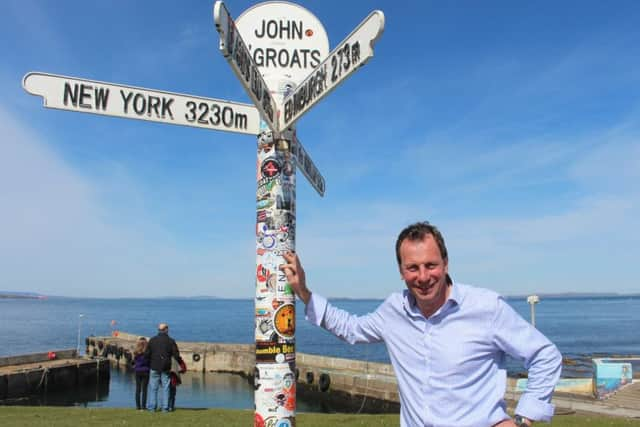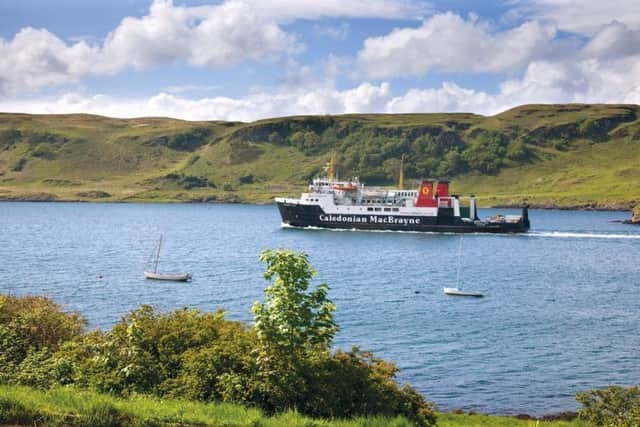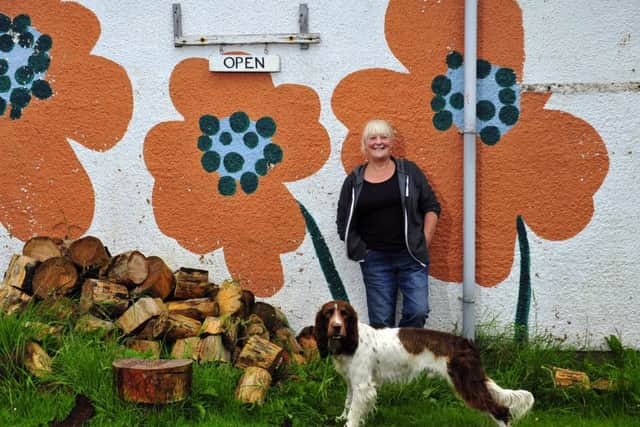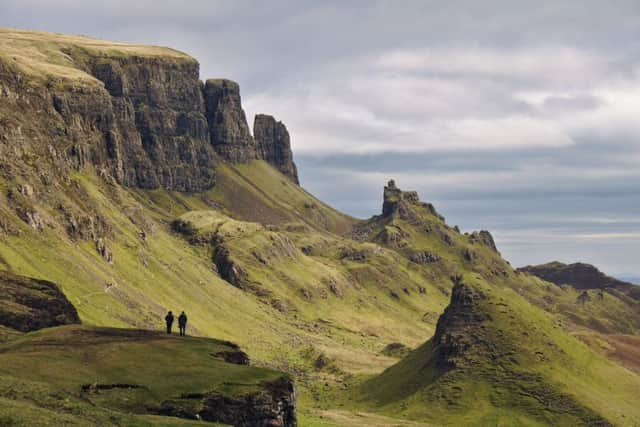Insight: Visitor numbers drive Highlands into tourist trap
They chatter in Swedish, German, French and English, turning the air into a Babel-like babble of holiday excitement. Jon and Karen Elliott, from High Wycombe in Buckinghamshire, are dreaming of the vast white beaches where their two Labradoodles, now indolent at their feet, will soon be running free. Steve and Jane Crowther, from York, who visited last year, are remembering the seals and the birds of prey and the stag that stood so close to them on neighbouring Jura that they thought it must be tame. “It’s like being a million miles away from anywhere,” says Steve.
But the tourists have also come in search of the uisge beatha. Bunnahabhain, Lagavulin, Caol Ila, Laphroaig: names as sweet and rough on the tongue as the peat-soaked whiskies themselves. “This is a holy pilgrimage for us,” says Howard Dixon, who lives in Australia, but has spent the last month house-sitting on the Black Isle. “We were going to head to Skye, but when we heard how busy it gets, we thought: ‘Where better to go pay homage than the place that produces our favourite single malt?’”
Advertisement
Hide AdAdvertisement
Hide AdDixon is right about the crowds. Though his wife, Kate, received no response from the four B&Bs she emailed, and is now paying £140 a night for a three-star hotel in Bridgend, Islay is not yet as over-run as Skye, whose bridge has proved both a blessing and a curse.


Yet Islay too is in a state of flux; as the number of visitors grows year on year, and the island becomes more commercialised, its local residents are torn between their desire for, and their fear of, progress. As they watch the regular excretion of motorhomes and lorries on to the piers, they wonder if it will be possible to strike a balance between attracting more visitors and preserving all that makes Islay special; or if the essence of their community will be destroyed.
For now, Islay continues to be an idyll; a place where history and landscape come together in a scattering of standing stones, chambered tombs and Iron Age brochs. On the day I visit, the sun behind the 8th-century Kildalton Cross casts an eldritch shadow across the graveyard while, in a nearby field, sheep catch the light like pearls on a green crushed velvet dress.
But, as its whisky and tourism industries grow, the dynamic is changing; the island’s 239 square miles now contain eight distilleries, with at least three more set to open in the next few years. The distilleries are mostly foreign-owned and becoming increasingly corporate and gimmicky in an attempt to attract more visitors.
Near the whitewashed Laphroaig Distillery lies a field dotted with small flags which mark out one-foot-square plots of land “owned” by anyone who has ever bought a bottle. Along the road, at its similarly dazzling rival, Ardbeg, parties of Japanese tourists stop to take selfies beside a giant copper still gleaming in the yard.


In contrast, the biggest distillery, Diageo-owned Caol Ila, at Port Askaig, which produces 6.5 million litres a year, looks slightly down-at-heel; but it is about to benefit from a £150 million investment aimed at upgrading the visitor centres at the company’s key sites.
With the distilleries comes congestion as huge vehicles trundle across the island’s narrow, patchy roads. Local businessman, Donald Gillies, owner of GTi Transport, a courier and grounds maintenance company, takes me on the “misery” tour, stopping to show me crater-like potholes at Claggan Bay, and the uneven spot where, just days earlier, a 24-tonne lorry toppled over, spilling its load into a field. We get out to take photographs; the smell of malted barley still hangs in the air.
The distilleries provide jobs, but as Gillies and others point out, Islay’s unemployment level is less than 1 per cent; meanwhile buildings and land are being swallowed up. “This is what is riling us,” says Gillies. “Islay is contributing millions to the economy, but there is no investment in infrastructure. The roads are so bad I am constantly having to shell out in terms of springs, suspension and vehicle maintenance.”
Advertisement
Hide AdAdvertisement
Hide AdIn the summer, Islay’s 3,200-strong population swells to around 9,000, and up to 20,000 during the Feis Ile whisky festival in May. Swish yachts berth at Port Ellen and motorhomes park on and off the designated sites. During last year’s festival, Mary Knowles, 89, a former biology teacher, was scandalised when she looked out of her window to see a man who had parked on nearby grassland relieving himself right in her eyeline. “I told him: ‘If you haven’t got the facilities, it’s time you moved on,’” she says, outraged.


The tourists bring money and vibrancy, but also noise and waste. They take up spaces on the overcrowded ferry, making it difficult for locals to travel to and from the mainland, and they put a strain on services. Some visitors buy second homes which stand empty much of the year, while young people struggle to find homes. For all these reasons, holiday-makers are both welcomed and resented.
As a chef at a local restaurant, who also owns three self-catering cottages, you might expect Robert McKim to be all for a flourishing tourist trade, yet he is ambivalent. “We are booming, yes, but the numbers are just too huge,” he says. “We can’t cope. There isn’t enough accommodation. Last summer, people turning up to find nothing available ended up spending a night in the police cells.”
This story may be apocryphal, but the fears about Islay’s future are genuine. Dietmar Finger is a German car designer and artist who has been visiting the island for two decades. Last year, he gave up his job with Volkswagen to open up a B&B in Carnduncan near Loch Gorm. When he isn’t catering for his four guests, he paints and runs art classes.
“I am worried more distilleries will be overkill and the island will be left with a whisky monoculture,” he says. Finger wants Islay to encourage “quality tourism”: a mix of hikers, wildlife lovers, malt drinkers and artists, rather than focusing so heavily on marketing the whisky “brand”.


“I sell my art during the Feis Ile and tourists there tell me Islay is already losing some of its magic,” he says. “I worry we will go the same way as some Spanish islands where the hotels have got bigger and bigger and now they are forced to import water from the mainland.”
The rise in distilleries is a problem specific to Islay, but over-tourism is a concern across rural Scotland. Skye suffers from a shortage of accommodation, while the Old Man of Storr and the Quiraing – once quiet spaces in which to stand and contemplate man’s place in the universe – are now clogged up with people. Ditto Orkney, which can see two or three cruise ships a day dock at Kirkwall and Stromness; each ship brings a fresh army of visitors who troop through historically important sites such as Skara Brae, Maeshowe and the Italian Chapel and move on.
These tourists are a product of successful and aggressive marketing. VisitScotland has long been selling the north of the country as one of the world’s great wildernesses, its dark, foreboding glens and swathes of emptiness among its chief selling points. “However much you want to promote Scotland as a new, dynamic growing nation, the old image from the mid-19th century is still very powerful,” says Richard Butler, emeritus professor of tourism at Strathclyde University. Scotland’s reputation as a holiday destination was already secure; but then along came TV series such as Outlander, with their shots of castles and cairns. Add to that the country’s relative stability (lack of terrorism), the rise of the staycation and a deflated pound and it’s no surprise visitor numbers exploded.
Advertisement
Hide AdAdvertisement
Hide AdOnce you have successfully marketed a brand, however, it’s difficult to unmarket it, even if the infrastructure is insufficient for the numbers you attract. “It’s the usual thing: there’s a good side and a bad side,” says Butler, who is editing a book on the tensions experienced in tourist magnets around the world. “From the point of view of employment and income and keeping places viable, it is wonderful. But Scotland has the image of being a beautiful country with beautiful scenery and historic buildings, and you don’t expect, as a tourist, to have to negotiate a single-track road packed with cars.
“Over-tourism is a problem relative to expectation as far as visitors are concerned and it’s a problem of quality of life as far as communities are concerned.”
A classic example of how clever branding can have unforeseen consequences is the North Coast 500 (NC500). The 516-mile route that runs in a loop from Inverness to Applecross to Durness to John o’Groats and back to Inverness has existed for decades, its twists and turns appreciated at a leisurely pace by those who love to explore lonely, brooding spaces. But in 2015, the North Highland Initiative (NHI) decided to market it as Scotland’s answer to Route 66; a real-life board game, where players travel from square to square, collecting photographs and “passport” stamps. People literally go there, do that and buy the T-shirt (and the baseball caps and the bumper stickers) though not necessarily in that order.
At Balnakeil Craft Village near the north-westerly tip of Scotland, former anthropologist Anita Wilson, who runs Cast-Off Crafts, observes the NC500 bucket-listers with a sceptical eye. “A lot of people walk in and immediately announce that they are ‘doing’ the route: it’s like a badge of honour,” she says. “Sometimes they apologise for doing it the wrong way, and I say: ‘Well, there isn’t a wrong way. It’s two-way traffic. I’ve been driving on it since the 1980s.’ Farmers were probably driving cattle down it in the 1700s.
“You look at these folk with their matching T-shirts and you wonder: ‘Do you not have an identity other than this?’ It’s this weird kind of sheep mentality. I bet if you sent up a drone to take an aerial view of the 500, it would look like a Scaletrix track with all the cars just whizzing round, one after the other.”
According to one study, the NC500 marketing initiative brought an extra 29,000 people and £9m to the Highland’s economy in its first year, while increasing traffic by 10 per cent.
Balnakeil does seem busy. Cars snake their way through the conglomeration of bunker-like units, past Cocoa Mountain, The Wee Gallery and The Whale Tale, trying to find somewhere to park. Created to house workers for a planned Cold War radar station, then rented out to artists when the station became obsolete, it appears to be thriving. But Wilson says the fortunes of Balnakeil have always ebbed and flowed and the recent marketing drive has made little difference to her takings. Joining the NC500 Club brings members special offers on certain hotels and shops, but businesses like hers are too small to absorb the 10 per cent discount so miss out on the extra custom. She does, however, feel the negative impacts: the extra time she has to add on to her journey to pick her grandson up from school in Thurso, and the way all the bread and milk in the local shop is sold out by 4pm. Meanwhile, some regular customers have stopped coming to Durness because they feel it is too crowded.
“I am happy to share this beautiful place; it would be mean not to,” says Wilson. “But you hope people respect it in the way you do; that they don’t just pass through like someone on a train, leaving chaos and detritus behind.”
Advertisement
Hide AdAdvertisement
Hide AdAs I drive the 68-mile stretch of the NC500 from Ullapool to Durness, mist drapes itself low over the mountains. The road weaves its way through a sparse landscape of alien shapes; a mossy Monument Valley. Long stretches of nothingness are relieved by fleeting glimpses of splendour: a jagged promontory here, a glistening loch there. The last 15 miles is mostly single track with passing spaces; you travel on through gothic hills negotiating your way past motorhomes and convoys of motorbikes until – suddenly, unexpectedly – the Kyle of Durness, an expanse of salmon-pink sands fringed with ochre seaweed, is spread out before you like a pashmina.
The walls of landscape photographer Kevin Arrowsmith’s gallery in Durness are covered with spectacular shots of Assynt, Cape Wrath and other beauty spots. Arrowsmith moved to the village more than ten years ago when his wife became the local midwife. He still loves living there, but says the marketing of the NC500 makes it difficult to get around.
“We are getting increased numbers of visitors in huge vehicles they may never have driven before,” he says. “Not all of them are bad drivers, but they are on holiday so, understandably, they drive slowly to look at the scenery. Some of them don’t understand how single-track roads work so they don’t move into passing places to allow the cars behind to pass or they suddenly swing across the road into a passing place on the opposite side. I have been in two or three near-collisions. Also, the roads are crumbling and Highland Council doesn’t have the budget to do anything about it.”
If anyone ought to welcome the NC500, it’s Fiona Mackay. She and her husband Rob own a B&B/hotel with seven rooms, a bunk house, some self-catering properties and the local Spar shop. But even she is dubious about its impact.
She says the success of the marketing initiative, which encourages people to secure rooms in advance, means she is currently taking bookings for September 2019. But people who have booked so far in advance are more likely to back out. Last week, she had two cancellations. And customers no longer walk in off the street.
More than the cancellations, however, Mackay is concerned about the rise in the number of motorhomes and wild campers in the Balnakeil dunes, which are an SSSI site. “Every Sunday morning Rob and I go down to the beach [Sango Sands], and recently we found three toilet rolls lined up on the shoreline. I see people pulling stones off beautiful old dykes to make fires. They have a whale of a time at night, then leave the dregs behind. That cannot go on.”
Mackay believes the community should become more pro-active in developing local plans, but she would also like to see Scotland take a similar approach to New Zealand when it comes to motorhomes. There, vans which are not self-sufficient have to park on designated sites where there are full recycling and waste disposal facilities.
NHI chairman David Whiteford is a powerful advocate for the NC500. The NHI was set up at the behest of Prince Charles in an attempt to reinvigorate parts of the Highlands’ fragile economy and Whiteford says the success of the route has allowed several closed hotels, such as The Portland Arms in Lybster, to reopen.
Advertisement
Hide AdAdvertisement
Hide Ad“It’s worth remembering that many of these places were busier in times gone by,” he says. “That whole Dornoch, Embo, Brora beach strip and the likes of Sands at Gairloch, where I was taken as a child, were once the beach holiday of choice. People started to move abroad to have their holidays and now they are coming back for all sorts of reasons. All we are really doing is reawakening public awareness of the amazing opportunities this beautiful part of Scotland affords.”
Whiteford says the NHI is acutely aware of the need to balance the drive to increase tourism with a concern for the environment. To that end, the organisation has set up a strategy group involving “stakeholders” such as Highland Council, Police Scotland and Scottish Natural Heritage. It is also organising beach clean-ups with Keep Scotland Beautiful, trialling funnel bins and asking camper van and motorhome companies to show clients where the waste disposal points are and encourage them to buy their food locally.
But NHI exists primarily to promote the route; investment in infrastructure can only come from the Scottish Government or Highland Council. In the autumn, the Scottish Government launched a £6m tourism infrastructure fund and last week Highland Council announced another £1.5m to be spent on road repairs. But, when you think it’s costing £3bn to upgrade the A9, these sums seem like a drop in the ocean.
They are certainly not enough to offset a belief among residents that the country’s local and central governments are taking out more from the Highlands and islands than they are putting back in.
When asked about official responsibility for protection of the environment in these areas a Scottish Government spokesperson says: “The new Islands Act includes the principle of ‘island-proofing’, which is a duty for public authorities, including Argyll and Bute Council in relation to Islay, to consider the particular needs and circumstances of island communities in what they do.”
But therein lies a problem. In Islay, the sense of powerlessness is compounded by the fact that the island lacks its own council. Instead, it is part of Argyll and Bute, which stretches from Campbeltown on the Kintyre peninsula to Tobermory on Mull. “We get what we are told we are getting by Kilmory [council HQ at Lochgilphead] and Kilmory will always put Helensburgh, Campbeltown, Lochgilphead and Dunoon first,” says Gillies.
Though their local authorities must be aware of the problem caused by human waste, Highlands and islands communities have had to campaign to prevent the closure of public toilets; both communities also claim any road repairs that have been carried out in 2018 have been quick fixes done on the cheap.
So I ask Professor Butler: if rural areas are being used as cash cows – contributing large sums to the country’s economy – are they not entitled to expect money to be ploughed into creating sufficient infrastructure?
Advertisement
Hide AdAdvertisement
Hide Ad“The short answer is, yes they are,” he replies. “The problem is, that if you are a government, of whatever colour, Islay is very small-scale. You look at problems in urban centres such as Glasgow and Dundee and you are talking about tens or hundreds of thousands of people versus a few thousand in Islay. Small populations have always been put way down the scale. And in all fairness, if you are a government looking at this, Islay is going to produce its whisky, whatever you do or you don’t do.”
In terms of controlling numbers, Butler says the main options are restricting flights or ferries (which would also penalise locals) or introducing tolls or taxes. “I don’t see any Scottish government wanting to send out a message that tourists aren’t wanted – it’s a big industry, it provides employment. Countries like Switzerland and the Maldives have cut down numbers by limiting accommodation and raising prices. But do you want to price people out of seeing Skye because they can’t afford £250 a night?”
It’s the paradox of wildernesses from Yosemite National Park to Everest: that the very quality that makes them alluring to tourists – their ruggedness and their isolation – is diminished as soon as those tourists arrive. If no-one takes control, how will our wide open spaces be preserved?
This is something that troubles Anita Wilson. Before she moved to Balnakeil, she lived in the Lake District, an area she believes has been “decimated and ruined”. “I believe you can see the track up Helvellyn from space now,” she says. “It’s the most beautiful mountain in the most beautiful area and it has this massive scar up the middle of it.”
Recently, Wilson read a piece in a local newspaper suggesting Durness and the surrounding areas ought to be offering tourists “more”. She looks askance. “What more could you possibly want to offer tourists other than pristine beaches, awesome scenery, views that go on forever, clean air, a relaxed way of life?” she says.
“You don’t have to put a fairground at the end of every pier, do you? If you want that, go to Land’s End. The extreme out-there-ness of here: that’s enough of more.”